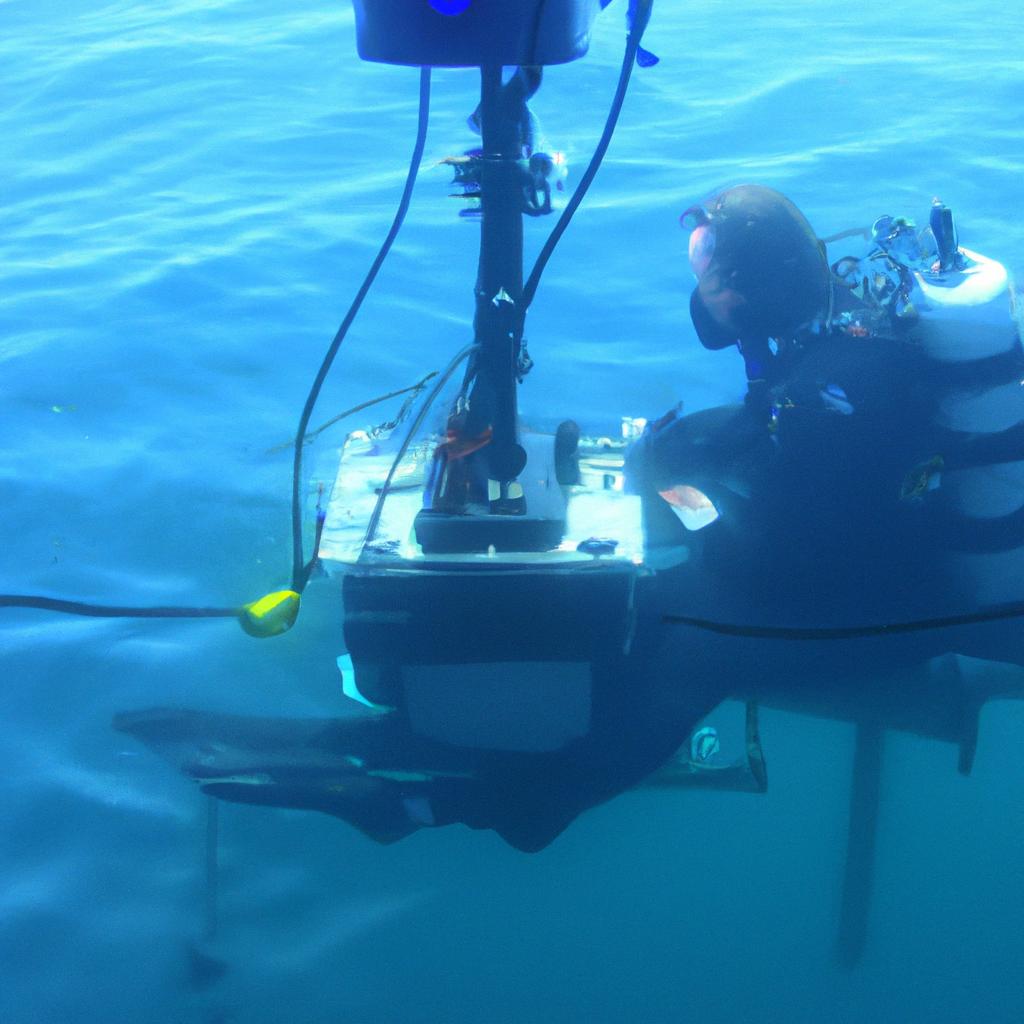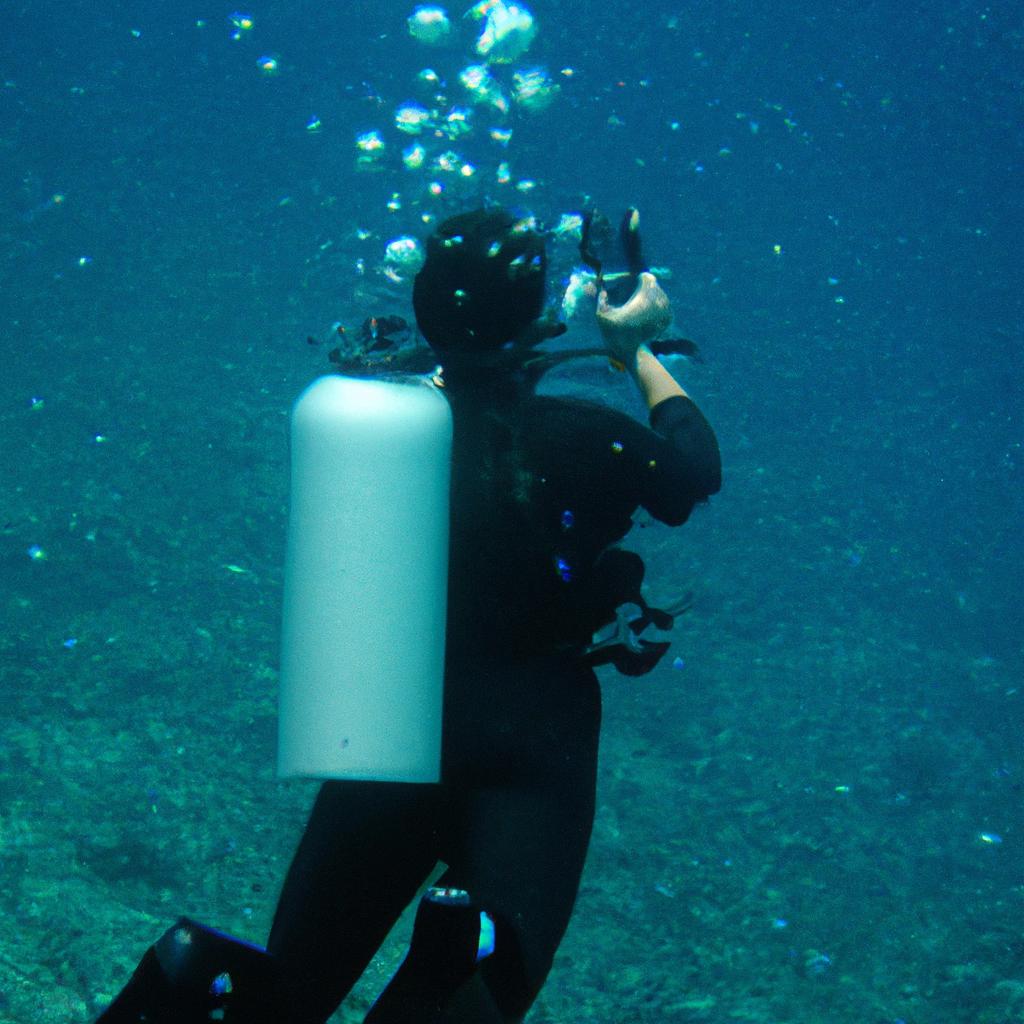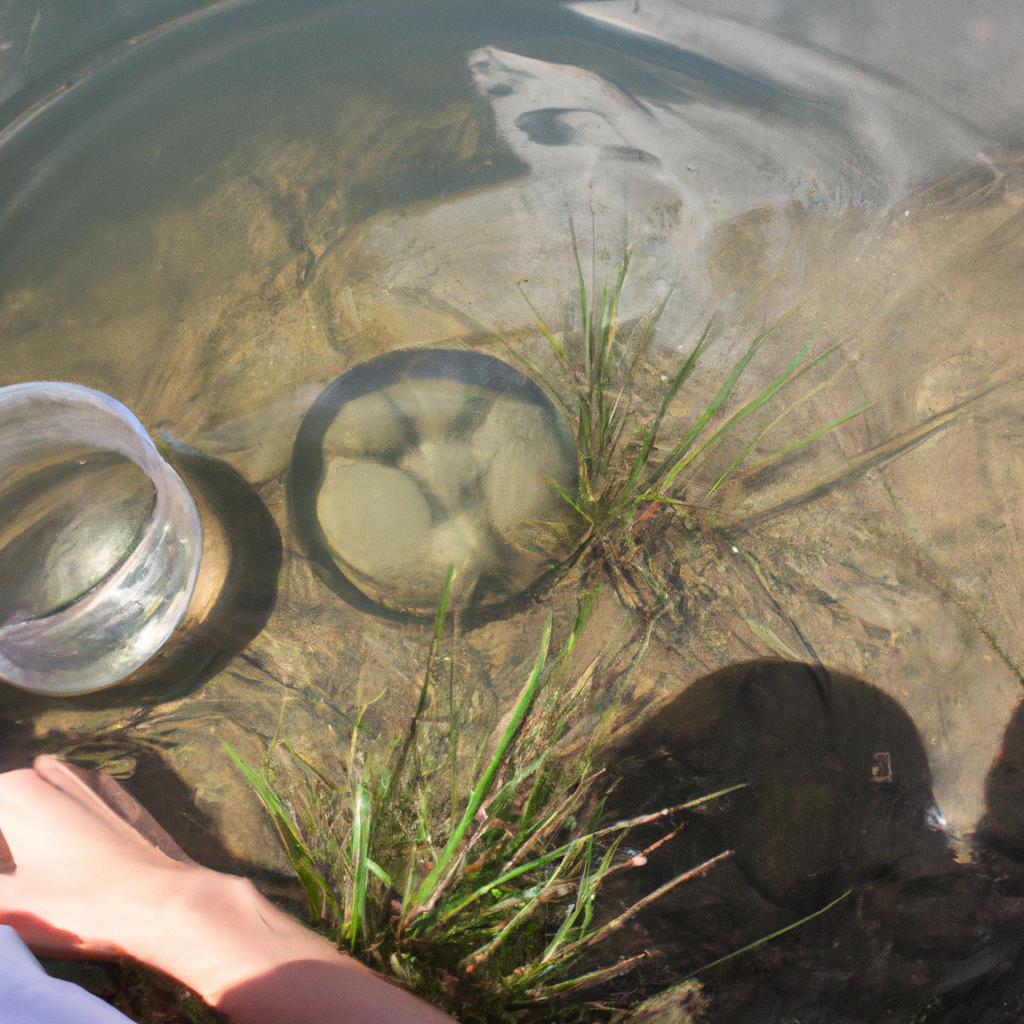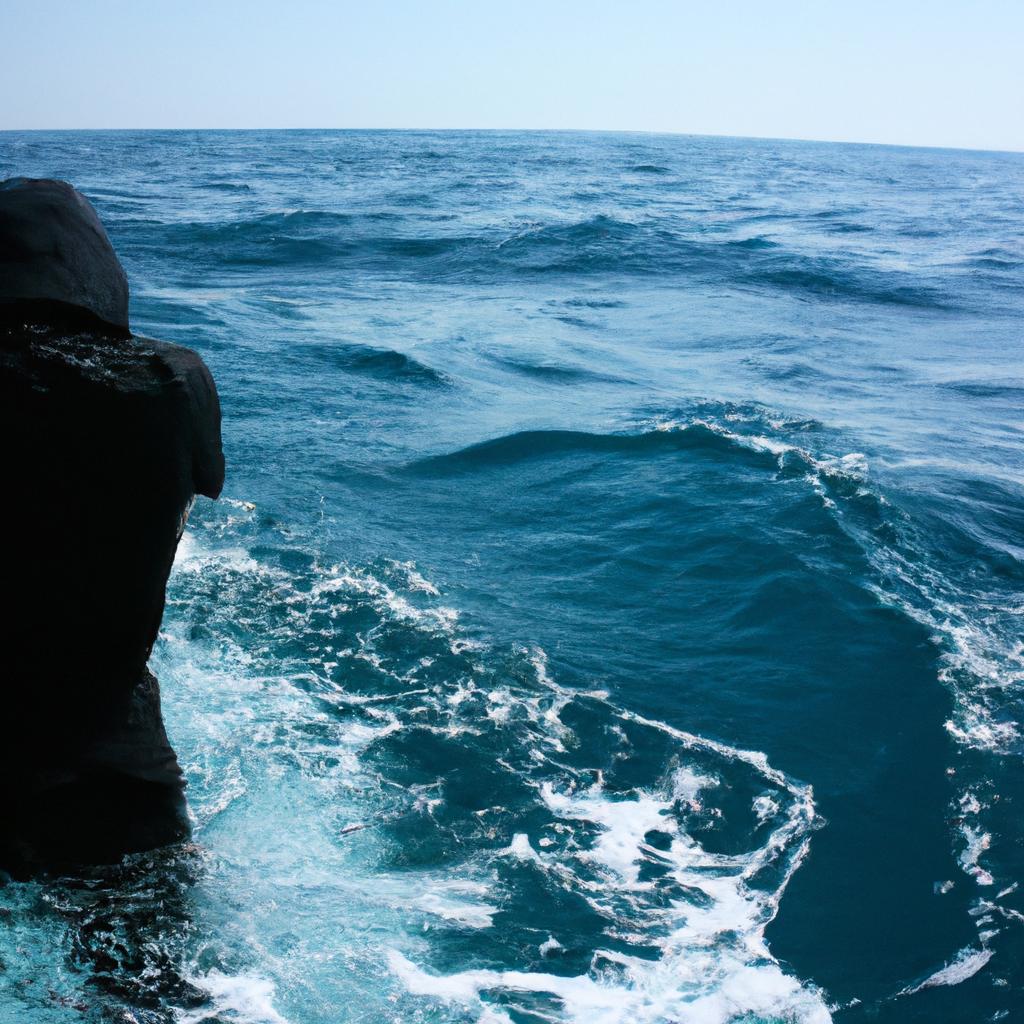Coral reefs, with their vibrant underwater ecosystems and intricate formations, are a topic of great significance in the fields of Earth sciences and oceanography. These delicate structures provide invaluable insights into various aspects of our planet’s history and offer a wealth of information about the oceans’ current state. For instance, let us consider the Great Barrier Reef – an iconic coral reef system located off the coast of Australia. This massive structure spanning over 2,300 kilometers is not only breathtakingly beautiful but also serves as a natural laboratory for scientists to study climate change impacts on marine life.
Understanding the importance of coral reefs requires delving into their role as indicators of environmental changes throughout time. By analyzing variations in coral growth rates, composition, and fossil records within these ancient organisms, researchers can decipher past climatic conditions such as sea surface temperatures and carbon dioxide levels. Moreover, studying modern-day coral reefs allows scientists to monitor ongoing trends like ocean acidification and rising sea temperatures caused by human activities. Such investigations enable us to gain critical insight into how anthropogenic factors impact fragile ecosystems and contribute to global environmental shifts. Ultimately, comprehending these complex relationships between corals and their surroundings has far-reaching implications for both scientific research and conservation efforts aimed at preserving these extraordinary habitats for generations to to come. By studying coral reefs, scientists can not only gain a deeper understanding of how our planet has evolved over time but also develop strategies to mitigate and adapt to the effects of climate change. Conservation efforts are crucial in protecting these delicate ecosystems from pollution, overfishing, and other human activities that can disrupt their fragile balance. Through sustainable practices, marine protected areas, and public awareness campaigns, we can work towards preserving coral reefs and ensuring their continued contribution to the health of our oceans and the wellbeing of countless species that rely on them for survival.
Formation of Coral Reefs
Coral reefs are intricate ecosystems formed through a fascinating process that spans thousands of years. One example to illustrate this formation is the Great Barrier Reef, located off the northeastern coast of Australia. Over time, millions of tiny coral polyps have built upon one another to create this magnificent structure, stretching over 2,300 kilometers and visible even from space.
The formation of coral reefs can be divided into three main stages. Firstly, it begins with individual coral larvae attaching themselves onto hard surfaces such as rocks or shipwrecks on the ocean floor. This initial attachment serves as the foundation for further growth. As more corals settle in these areas, they secrete calcium carbonate exoskeletons that provide structural support and protection against predators. The accumulation of these skeletons forms large colonies known as coral heads.
In the second stage, called consolidation, these coral heads continue to grow and multiply through asexual reproduction. Parental polyps bud new offspring which remain connected within the colony. This interconnected network enables efficient sharing of nutrients and enhances collective survival. Furthermore, sedimentation helps cement together loose particles and strengthens the overall reef structure.
Lastly, during the final stage known as colonization, other organisms like algae and sponges colonize spaces between coral branches. These interactions foster symbiotic relationships where both parties benefit: the corals gain access to additional nutrients while providing shelter for their partners. Such mutualistic associations contribute significantly to reef biodiversity.
To fully appreciate the beauty and importance of coral reefs, let us consider some awe-inspiring facts:
- Coral reefs are often referred to as “rainforests of the sea” due to their incredible biodiversity.
- They harbor approximately 25% of all marine species despite occupying less than 1% of Earth’s surface.
- Coral reefs provide habitats for countless fish species whose vibrant colors adorn underwater landscapes.
- Moreover, these ecosystems act as natural barriers protecting coastal communities from storms and erosion.
As we delve deeper into the significance of coral reefs, it becomes apparent that their formation is just the beginning. The subsequent section will explore the role of these invaluable ecosystems in supporting biodiversity and providing essential ecosystem services.
Biodiversity and Ecosystem Services of Coral Reefs
Section H2: Biodiversity and Ecosystem Services of Coral Reefs
In the previous section, we explored the formation of coral reefs and how they play a fundamental role in shaping our planet’s underwater landscapes. Now, let us delve into another captivating aspect of coral reefs – their immense biodiversity and the invaluable ecosystem services they provide.
To illustrate the significance of coral reef biodiversity, consider the Great Barrier Reef off the coast of Australia. This magnificent natural wonder spans over 2,300 kilometers (1,400 miles) and is home to an astonishing array of marine life. From vibrant corals to countless fish species, turtles, sharks, rays, and an abundance of other organisms coexist within this complex ecosystem. The interplay between these diverse creatures creates a delicate balance that sustains not only themselves but also neighboring ecosystems such as seagrass beds and mangrove forests.
The importance of coral reefs extends far beyond their inherent beauty. These fragile ecosystems provide numerous essential services that benefit both humans and nature:
- Habitat for Marine Life: Coral reefs serve as vital nurseries and homes to approximately 25% of all known marine species.
- Coastal Protection: Acting as natural barriers against storms and wave energy, healthy reefs significantly reduce coastal erosion and mitigate the impacts of climate change-induced sea-level rise.
- Fisheries Support: Over half a billion people worldwide depend on fisheries associated with coral reefs for their livelihoods or as a crucial source of protein.
- Tourism Revenue: Coral reef tourism generates billions of dollars annually through activities such as diving, snorkeling, and wildlife watching.
Table: Economic Value Provided by Coral Reefs
| Ecosystem Service | Annual Estimated Value |
|---|---|
| Shoreline protection | $9-12 billion |
| Commercial fishing | $5.7 billion |
| Coastal tourism | $11.9 billion |
| Climate regulation & carbon storage | $1.9 trillion |
As awe-inspiring as coral reefs and their ecosystem services are, they face significant threats due to climate change, pollution, overfishing, and habitat destruction. These challenges jeopardize the delicate balance and resilience inherent in these unique environments.
In the upcoming section on “Coral Bleaching and Climate Change,” we will explore how rising sea temperatures disrupt this harmony, leading to mass bleaching events that pose a severe threat to coral reef survival. By understanding these interconnected issues, we can work towards finding solutions to conserve and protect these invaluable natural treasures for generations to come.
Coral Bleaching and Climate Change
Building upon the understanding of coral reef biodiversity and ecosystem services, it is crucial to explore the pressing issue of coral bleaching and its relationship with climate change. By examining this topic, we can gain insights into the vulnerability of these delicate ecosystems and highlight the urgent need for conservation efforts.
Coral bleaching occurs when corals expel their symbiotic algae due to stressors such as increased sea temperatures or pollution. This phenomenon has garnered significant attention in recent years due to its devastating effects on coral reefs worldwide. For instance, let us consider a hypothetical scenario where rising sea temperatures lead to severe coral bleaching in the Great Barrier Reef, resulting in widespread mortality among corals. This case study highlights how climate change-induced events can trigger irreversible damage to one of the most iconic marine ecosystems on Earth.
To comprehend the intricate relationship between coral bleaching and climate change, several key factors must be considered:
- Increasing ocean temperatures: As global warming continues unabated, oceans absorb excess heat from greenhouse gas emissions, leading to elevated sea surface temperatures. This rise disrupts the thermal tolerance range of corals and triggers mass bleaching events.
- Ocean acidification: Increased carbon dioxide concentrations in the atmosphere not only contribute to global warming but also get absorbed by seawater, causing ocean acidification. Acidic conditions impede calcification processes necessary for coral growth and recovery following stress events.
- Extreme weather events: Climate change intensifies extreme weather phenomena like hurricanes and cyclones. These events pose a direct threat to coral reefs through physical damage caused by strong winds and wave action.
- Pollution and nutrient runoff: Human activities near coastlines introduce pollutants and excessive nutrients into water bodies. Nutrient-rich waters fuel algal blooms that shade corals, hindering photosynthesis and increasing susceptibility to bleaching.
Considered together, these factors create an alarming situation for our planet’s fragile coral reef ecosystems. To further illustrate this vulnerability visually:
| Impact of Climate Change on Coral Reefs |
|---|
| Rising ocean temperatures |
| Increased bleaching events and coral mortality |
Understanding the complex interplay between climate change and coral bleaching is essential for developing effective conservation strategies. By addressing these threats head-on through sustainable practices and global cooperation, we can work towards safeguarding these invaluable ecosystems.
Transition into the subsequent section about “Coral Reefs as Indicators of Environmental Health”: As coral reefs face escalating challenges due to climate change-induced stressors, they serve as valuable indicators of environmental health. Through their responses to changing conditions, corals provide crucial insights that extend beyond their own existence.
Coral Reefs as Indicators of Environmental Health
Having examined the detrimental effects of coral bleaching caused by climate change in the previous section, it is important to recognize that coral reefs serve a crucial role in indicating the overall health of our environment. One example illustrating this significance is the Great Barrier Reef located off the coast of Australia. With its immense biodiversity and vibrant ecosystem, this reef has long been considered an ecological marvel. However, recent studies have shown alarming declines in coral cover and species diversity due to pollution, overfishing, and coastal development.
The decline of coral reefs serves as a distress signal warning us about the deteriorating state of our oceans and ultimately our planet’s overall environmental health. By monitoring changes in coral reefs, scientists can gain valuable insights into various aspects of marine ecosystems. Here are some key reasons why coral reefs act as effective indicators:
- Biodiversity: Coral reefs provide habitat for approximately 25% of all known marine species despite covering less than 1% of the ocean floor. Declines in coral cover directly impact these diverse organisms and disrupt entire food chains.
- Water Quality: The presence or absence of certain species within a reef can indicate water quality conditions such as excessive nutrients or pollutants. Changes in water quality affect not only corals but also other marine life dependent on them.
- Ocean Acidification: As carbon dioxide levels rise due to human activities, seawater becomes more acidic. This acidification inhibits the growth and calcification processes crucial for healthy coral reef formation.
- Climate Change Resilience: Coral reefs possess varying degrees of resilience to climate change impacts such as rising sea temperatures and extreme weather events. Studying resilient reefs helps identify strategies for conservation efforts and assists policymakers in making informed decisions.
To further emphasize their importance, consider the following table showcasing statistics related to global coral reef degradation:
| Categories | Statistics |
|---|---|
| Total Coral Cover | 50% lost |
| Species Diversity | 30% decline |
| Economic Value | $375 billion/year (estimated) |
| Coastal Protection | Protects over 150,000 km of coastline |
The alarming figures presented above serve as a stark reminder of the urgent need to protect and restore our coral reefs. By implementing sustainable practices and reducing human impacts on marine environments, we can help ensure the long-term survival of these invaluable ecosystems.
Transitioning into the subsequent section about “Threats to Coral Reefs,” it is imperative to delve deeper into understanding the various challenges faced by coral reefs around the world. Examining these threats will shed light on necessary measures that must be taken to mitigate their impact and preserve these fragile underwater habitats for future generations.
Threats to Coral Reefs
Section H2: Threats to Coral Reefs
Having explored the significance of coral reefs as indicators of environmental health, we must now turn our attention to the multitude of threats that these fragile ecosystems face. The delicate balance upon which coral reefs thrive is being disrupted by various factors, posing a significant challenge for their long-term survival.
Threats to coral reefs are diverse and multifaceted. One notable example is the phenomenon known as coral bleaching. When corals experience stress due to changes in temperature, pollution, or excessive exposure to sunlight, they expel the symbiotic algae living within their tissues. This leads to a loss of coloration and renders the corals vulnerable to disease and death. A real case study conducted in the Great Barrier Reef revealed alarming rates of bleaching caused by rising ocean temperatures linked to climate change.
The following bullet point list highlights some key threats faced by coral reefs:
- Ocean acidification resulting from increased carbon dioxide absorption.
- Overfishing disrupting ecological balances.
- Pollution from agricultural runoff and coastal development.
- Destructive fishing practices such as dynamite fishing.
To further illustrate the impact of these threats on coral reef ecosystems, consider Table 1 below:
| Threat | Consequences | Case Study |
|---|---|---|
| Coral Bleaching | Loss of biodiversity | Great Barrier Reef |
| Ocean Acidification | Reduced calcification rates | Caribbean Sea |
| Overfishing | Altered food chains | Indo-Pacific region |
| Pollution | Increased susceptibility | Red Sea |
As evident from both the list and table above, each threat has its own set of consequences that compound one another, exacerbating the overall degradation of coral reefs worldwide. Urgent action is required to address these challenges if we are to preserve these invaluable marine ecosystems for future generations.
In light of this pressing need, the subsequent section will delve into conservation and restoration efforts for coral reefs. It is imperative that we explore effective strategies to mitigate these threats and promote the recovery of damaged reef systems.
Conservation and Restoration Efforts for Coral Reefs
Threats to Coral Reefs have been widely recognized as a significant concern in recent years. As our understanding of the importance and fragility of coral reefs continues to grow, it becomes increasingly imperative for us to address these threats through conservation and restoration efforts. This section will explore some of the key initiatives that are currently being undertaken worldwide.
One example of a successful conservation effort is the Great Barrier Reef Marine Park Authority (GBRMPA) in Australia. The GBRMPA has implemented various strategies to protect the world’s largest coral reef system, including zoning regulations, monitoring programs, and community engagement. By carefully managing human activities such as fishing, tourism, and coastal development, they aim to mitigate stressors on the ecosystem and ensure its long-term survival.
In addition to specific case studies like the GBRMPA, there are several broader approaches that can be taken to conserve and restore coral reefs:
- Strengthening legislation: Governments can enact strict laws and regulations related to marine protection, pollution control, and sustainable resource management.
- Promoting awareness and education: Raising public awareness about the value of coral reefs and their vulnerability can help garner support for conservation efforts.
- Encouraging sustainable practices: Implementing sustainable fishing methods, reducing pollution from land-based sources, and promoting responsible tourism can all contribute to safeguarding coral reefs.
- Supporting scientific research: Continued scientific research is crucial for gaining a deeper understanding of coral reef ecosystems, their dynamics, and potential solutions for preservation.
To further illustrate the significance of these initiatives in conserving coral reefs, consider the following table highlighting some alarming statistics:
| Threat | Impact |
|---|---|
| Climate change | Bleaching events leading to mass mortality |
| Overfishing | Disruption of ecological balance |
| Pollution | Reduced water quality affecting health of corals |
| Coastal development | Habitat destruction due to dredging or sedimentation |
These numbers serve as a stark reminder of the urgent need to take action. By implementing effective conservation and restoration strategies, we can protect these invaluable ecosystems for future generations.
In summary, threats to coral reefs pose a serious risk to their survival and require immediate attention. Through initiatives like those undertaken by the GBRMPA and broader approaches such as strengthening legislation, promoting awareness, encouraging sustainable practices, and supporting scientific research, we can make significant strides in preserving these vital ecosystems. With the alarming statistics presented above serving as a call to action, it is imperative that we act swiftly and decisively to secure the future of coral reefs worldwide.










